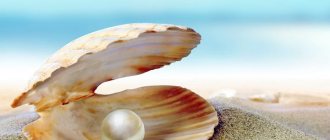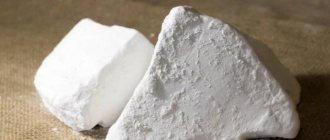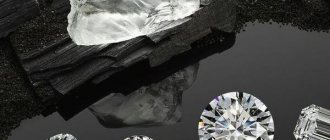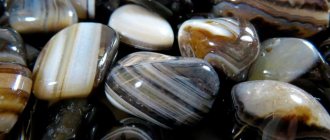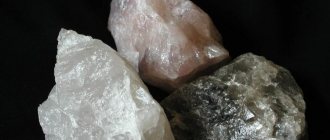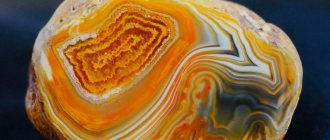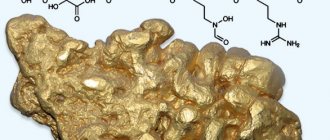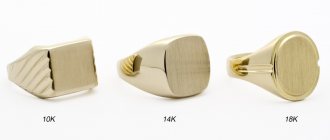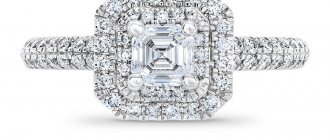During a volcanic eruption, magma comes to the surface of the Earth. As the magma, or lava, cools and hardens, it forms volcanic rocks. According to statistics, over the past 180 million years, an average of 30 cubic kilometers of volcanic material has been carried to the Earth's surface annually. About 75% of volcanic rocks accumulated at the bottom of the oceans, 20% on islands in the zones of transition from oceans to continents, and only 5% on land.
Deep magma rises through unnatural channels and cracks in the earth's crust and forms volcanic nappes and active volcanoes. On its way to the surface, it loses the gases it contains and is poured out in a degassed state. The erupted magma is called lava . In contact with the atmosphere, lava quickly cools and hardens, forming volcanic or effusive rocks. The speed of cooling determines the special structure of volcanic rocks: they are characterized by small crystals, many of which cannot be seen with the naked eye. In addition, they often contain glass, a non-crystalline substance formed as a result of the ultra-rapid cooling of magma.
Volcanoes and volcanic activity on the planet
Volcanoes
– geological formations that arise under channels and cracks in the earth’s crust, through which lavas, hot gases and rock fragments erupt onto the earth’s surface from deep magmatic sources. Typically, volcanoes are individual mountains composed of eruption products.
Fig.1.
Hypothetical sections of the structure of some types of volcanoes and their roots Volcanoes are divided depending on the degree of volcanic activity into active, dormant, extinct and dormant. An active volcano is considered to be a volcano that erupted during a historical period of time or in the Holocene. The concept of active is quite inaccurate, since a volcano with active fumaroles is classified by some scientists as active, and by others as extinct. Dormant volcanoes are considered to be inactive volcanoes where eruptions are possible, and extinct volcanoes are considered to be those where they are unlikely.
However, there is no consensus among volcanologists on how to define an active volcano. The period of volcanic activity can last from several months to several million years. Many volcanoes exhibited volcanic activity tens of thousands of years ago, but are not considered active today.
Astrophysicists, from a historical perspective, believe that volcanic activity, caused, in turn, by the tidal influence of other celestial bodies, can contribute to the emergence of life. In particular, it was volcanoes that contributed to the formation of the earth's atmosphere and hydrosphere, releasing significant amounts of carbon dioxide and water vapor. Scientists also note that too active volcanism, such as on Jupiter's moon Io, can make the planet's surface uninhabitable.
At the same time, weak tectonic activity leads to the disappearance of carbon dioxide and sterilization of the planet. “These two cases represent potential boundaries for planetary habitability and exist alongside the traditional parameters of habitable zones for systems of low-mass main sequence stars,” the scientists write.
Decorations made of stones
Minerals can simply be beautifully distributed along the bottom or you can make various designs out of them. Grottoes, fairy-tale castles, and fantasy-style figures look good in an aquarium. You can use the stones in the aquarium to create original compositions with your own hands, which will become unique works of art. Such aquariums bring relaxation, similar to contemplation of the sea.
If an aquarist likes the aquascape technique, he needs to choose uneven, textured, dark rocks. Too smooth specimens without color inclusions look boring and unnatural. You should not select stones of the same color as the soil, they will merge and there will be no effect. Imitating a corner of a body of water is impossible without creating irregularities. It is advisable to leave the ground level only in the foreground. In this case, the landscape will look like a completed panorama.
When creating decorations, you need to remember that they need to be washed, cleaned, and cleared of green deposits. This procedure is performed at the time of water change. If you do not take care of stone structures, they will lose their individuality and merge into the general mass.
Creating an aquarium landscape is considered an art form. Structures made of stones become elements of such “pictures”
It is important not only to be able to create fancy decorations, but also to choose and prepare the material correctly. If everything is done correctly, the stones will bring magic and grace, creating a microcosm that you can admire forever
When creating aquariums, you need to use stones that allow you not only to successfully implement decorative ideas, but also to guarantee improved living conditions for aquarium inhabitants. Moreover, natural stones turn out to be useful not only for fish, but also for green plants, the vital activity of which largely depends on the type of stones used.
If you select or process stones incorrectly, there are serious risks for disease and even death of fish. For this reason, the owner of an aquarium must be guided not only by wishes regarding types, sizes, shapes and methods of decoration, but also have practical knowledge. In many situations, sandstone, which is a natural type of stone, is used for aquariums.
Classification of volcanoes by shape
The shape of a volcano depends on the composition of the lava it erupts; Five types of volcanoes are usually considered:
Shield volcanoes, or "shield volcanoes". Formed as a result of repeated ejections of liquid lava. This form is characteristic of volcanoes that erupt low-viscosity basaltic lava: it flows for a long time both from the central vent and from the side craters of the volcano. Lava spreads evenly over many kilometers; Gradually, a wide “shield” with gentle edges is formed from these layers. An example is the Mauna Loa volcano in Hawaii, where lava flows directly into the ocean; its height from its base on the ocean floor is approximately ten kilometers (while the underwater base of the volcano is 120 km long and 50 km wide).
Cinder cones. When such volcanoes erupt, large fragments of porous slag are piled up around the crater in layers in the shape of a cone, and small fragments form sloping slopes at the foot; With each eruption the volcano gets higher. This is the most common type of volcano on land. They are no more than a few hundred meters in height. An example is the Plosky Tolbachik volcano in Kamchatka, which exploded in December 2012.
Stratovolcanoes, or "layered volcanoes". Periodically erupt lava (viscous and thick, quickly solidifying) and pyroclastic matter - a mixture of hot gas, ash and hot stones; as a result, deposits on their cone (sharp, with concave slopes) alternate. Lava from such volcanoes also flows out of cracks, solidifying on the slopes in the form of ribbed corridors that serve as the support of the volcano. Examples - Etna, Vesuvius, Fuji.
Rice. 2. Mount Fuji, Japan
Dome volcanoes. They are formed when viscous granite magma, rising from the depths of the volcano, cannot flow down the slopes and hardens at the top, forming a dome. It clogs its mouth, like a cork, which over time is knocked out by the gases accumulated under the dome. Such a dome is now forming over the crater of Mount St. Helens in the northwestern United States, formed during the 1980 eruption.
Complex (mixed, composite) volcanoes.
Phyllite
Not the last place in the list of rocks belongs to phyllites. They occupy an intermediate position between clayey and mica shales. The material is dense and fine-grained. Moreover, the stones are obviously crystalline, they are characterized by pronounced foliation.
Phyllites have a silky shine. Color scheme – black, shades of gray. Minerals are broken into thin slabs. Phyllites include:
- mica;
- sericite
There may be grains, crystals:
- albite;
- andalusite;
- grenade;
- quartz.
Phyllite deposits are rich in France, England and the USA.
Volcanic phenomena
Eruptions can be long-term or short-term. Precursors of an eruption include volcanic earthquakes, acoustic phenomena, changes in magnetic properties and the composition of fumarole gases. An eruption usually begins with increased emissions of gases, first along with dark, cold lava fragments, and then with hot ones. These emissions are in some cases accompanied by an outpouring of lava. The height of the rise of water gases saturated with ash and lava fragments, depending on the force of the explosions, ranges from 1 to 5 km. The ejected material is transported over distances ranging from several to tens of thousands of kilometers.
The volume of ejected debris sometimes reaches several cubic kilometers. During some eruptions, the concentration of volcanic ash in the atmosphere is so high that darkness occurs, similar to darkness in a closed room. The eruption is an alternation of weak strong explosions and outpourings of lava. Explosions of maximum force are called climactic paroxysms. After them, the force of the explosions decreases and the eruptions gradually cease. The volume of erupted lava is up to tens of cubic kilometers.
Types of eruptions
Volcanic eruptions are not always the same. Depending on the quantitative ratios of erupted volcanic products and the viscosity of lavas, 4gl. type of eruptions:
1. Effusive (Hawaiian)
2. Mixed (Strombolian)
3. Extrusive (dome)
4. Explosive (Vulcan)
Hawaiian type
eruptions that most often create shield volcanoes, characterized by a relatively calm outpouring of liquid lava, forming fiery liquid lakes and lava flows in the craters. Gases contained in small quantities form fountains, throwing out lumps and drops of liquid lava, which are pulled in flight into thin glass threads.
In the Strombolian type of eruptions, which usually creates stratovolcanoes, along with fairly abundant outpourings of liquid lavas of basaltic and andesite-basaltic composition, small explosions predominate, which throw out pieces of slag and a variety of twisted and spindle-shaped bombs.
For dome type
characterized by the squeezing and pushing out of viscous lava by a strong pressure of gases from the V. channel and the formation of domes, crypto-domes, cone-domes and obelisks.
In Vulcan type
Gaseous substances play a major role, producing explosions and emissions of huge black clouds filled with large amounts of lava fragments. Viscous lavas of andesitic, dacite or rhyolite composition form small flows. Each of the main types of eruptions is divided into several subtypes. Of these, the most notable are the Peleian and Katmai types, intermediate between the dome and Vulcan types. A characteristic feature of the first is the formation of domes and directed explosions of very hot gas clouds, overflowing with fragments and blocks of lava that self-explode in flight and when rolling down the slope of volcanoes.
Eruptions of the Katmai subtype are characterized by the ejection of a very hot, highly mobile sand flow. Dome-forming eruptions are sometimes accompanied by hot or fairly cool avalanches, as well as mud flows. The ultravolcanic subtype is expressed in very strong explosions, throwing out huge amounts of lava fragments and rocks of the channel walls. Eruptions of underwater volcanoes located in very deep places are usually invisible, because high water pressure prevents explosive eruptions. In small places, eruptions are expressed by explosions (ejections) of huge quantities of steam and gases, overflowing with small fragments of lava. Explosive eruptions continue until the erupted material forms an island rising above sea level. After which the explosions are replaced or alternated with outpourings of lava.
Fig.3. Eruption of the Tungurahua volcano in Ecuador
Products of volcanic eruptions
There are gaseous
,
liquid and solid. Depending on the nature of the eruptions and the composition of the magma, structures of various shapes and heights are formed on the surface. They are volcanic apparatuses consisting of a pipe-shaped or fissure channel, a vent (the uppermost part of the channel), thick accumulations of lavas and volcanoclastic products surrounding the channel on different sides, and a crater (a bowl-shaped depression located at the top of the structure).
The most common forms of structures are cone-shaped (with a predominance of ejections of clastic material), dome-shaped (with the squeezing out of viscous lava) and flat shield-shaped (with a predominance of outpourings of liquid lava). Eruptions occur not only through the summit vent. crater, but also through secondary (parasitic) craters located on the slopes and at some distance from them. With single eruptions of gases that pierce a channel to the earth's surface, funnel-shaped depressions are often formed, bordered by a ring shaft of blocks of various rocks. Such funnels, often filled with water, are called maars
.
Strong eruptions are sometimes accompanied by the collapse of part of the volcanic structure, and often the surrounding area. The resulting depressions with a diameter ranging from several kilometers to a few tens of kilometers are called calderas.
Theories of rock formation
The problem of granite formation is still the subject of scientific controversy. And the point here is not what minerals granite consists of, but the places of its formation and the conditions conducive to the emergence of such structures. By default, granite is classified as igneous rock, that is, its formation is, one way or another, associated with ancient volcanism and solidification of magma.
During volcanic activity in anhydrous conditions, basalts are formed, and other igneous rocks (pumice, tuff) are obtained when lava enters water. There is a hypothesis according to which granite is the product of a partial melt, and some solid inclusions are preserved in it. Its author was N. Bowen, who was engaged in experimental petrology. He established that granite massifs are associated with basalt ones, and the way they occur indicates the formation of granite together with basalt.
Other scientists are developing theories for smelting more fusible elements from massifs of igneous rocks, and still others attach great importance to the granitization of rocks due to the influence of water and ion exchange.
All of these theories can explain the origin of specific granite deposits, but none of them are completely applicable. In any case, they cannot explain how the granite layers of the continents were formed.
Geographical distribution of active volcanoes
Volcanoes are located along young mountain ranges or along major faults over hundreds and thousands of kilometers in tectonically mobile areas. Almost two-thirds of volcanoes are concentrated on islands and shores of the Pacific Ocean. Among other regions, the Atlantic Ocean region stands out in terms of the number of active volcanoes.
Circum-Pacific Belt (Circum-Pacific, Pacific Ring of Fire) - covers, according to various estimates, from 340 to 381 active land volcanoes. Of these, 59 are in South America, 70 in Central America, 46 in North America (including the Aleutian Islands), and, finally, 140 in the northwestern part of the belt (from Kamchatka to the Japanese Islands). The remaining volcanoes are located in the southwestern and southern parts of the belt (from the Ryukyu Islands through the islands of Micronesia, Melanesia and New Zealand to the coast of Chile).
Volcanoes of the Circum-Pacific Belt are located along narrow deep-sea trenches, at a distance of 100–200 km from their axis towards the continents. Seismic focal zones of Zavaritsky-Benioff are confined to the trenches, where a lithospheric plate with an oceanic-type crust moves under lithospheric plates with a continental structure of the earth's crust. Most volcanoes are located where the depth of seismic focal zones is 90–150 km. The volcanoes of this belt, according to the nature of their eruptions, belong to a variety of categories and types.
The Mediterranean-Indonesian (Mediterranean) belt, which encircles the planet in the latitudinal direction, includes from 117 to 175 active volcanoes. Of these, 13 land-based volcanoes (mostly of the pyroclast category) are known in the Mediterranean Sea area, and 123 land-based volcanoes (most of the explosive category) are known within the Malay Archipelago. The volcanism of this belt is also associated with active seismic focal zones, which, however, are relicts of the Neogene peak of Alpine folding. The most active volcanism here was apparently observed in the Neogene and the beginning of the Quaternary period, as evidenced by the numerous extinct volcanoes of the Carpathians, the Caucasus, the Iranian Plateau, and Tibet (on the territory of the latter there is also one active volcano - Rubruk).
The Atlantic belt is located in the axial meridional part of the Atlantic; all 44 active land volcanoes are located on the islands (from Jan Mayen Island to the Tristan da Cunha Islands). Most of the volcanoes here are associated with extensional rift structures, so the sources lie very shallow, and the composition of the lava is basaltic. The nature of the eruptions is dominated by effusive volcanoes (fissure type).
The East African belt, located within the largest continental rift system, includes 42 active land volcanoes, varying in lava composition and eruption patterns.
A small number of terrestrial volcanoes are located outside the named belts, being, for the most part, intraplate volcanoes. They are located both on islands in the oceans (Canary Islands, Cape Verde, Mauritius, Reunion, Hawaii) and on continents (Cameroon). And finally, at the bottom of the oceans there are a huge number of underwater volcanoes
Place of Birth
Deposits of igneous rocks have been explored everywhere.
Especially in Russia and adjacent territories:
- The north of the European part of Russia, the Urals, and Altai are rich in granites and gabbro.
- Porphyrites and diabases are mined in Altai, the Caucasus, the Urals, and Central Asia.
- Andesite mining has been established in Ukraine, the Caucasus, and Siberia.
- Armenia has the largest deposits of volcanic glass.
The volumes of extraction of magmatic raw materials are estimated in tons.
Causes of volcano activity
The location of volcanoes indicates a close connection between belts of volcanic activity and dislocated mobile zones of the earth's crust. The faults that form in these zones are channels. Along which magma moves to the earth's surface. The movement of magma through cracks and pipe-like channels to the earth's surface apparently occurs under the influence of tectonic processes.
At a depth. When the pressure of gases dissolved in magma becomes greater than the pressure above the underlying strata, the gases begin to rapidly advance and drag the magma towards the earth's surface. It is possible that gas pressure is created during the crystallization process of magma, when the liquid part of it is enriched with residual gases and steam. The magma seems to boil and, as a result of the intense release of gaseous substances, high pressure is created in the source, which can also be one of the reasons for the eruption.
Where are they used?
Igneous rocks are widely used:
- Granites are an elite building material.
Areas of application of granite - Diorite is used as a vibration damper (for example, in bridges).
- Peridotites and pyroxenites are in demand for hydraulic structures, interior design, and the manufacture of decorative items.
- A variety of gabbro labradorite is a decorative and facing material sold at a high price.
- Diabases become road surfaces.
- Basalts are acid-resistant, electrical insulator, source material for cast decor, pipes, and chemical instruments.
- Pumice is used as a filler for light grades of concrete and an additive to cement.
Using pumice stones for feet - Light varieties of andesites turn into the walls of buildings, dense ones are suitable for the manufacture of acid-resistant products.
Diorites, granites, and peridotites also serve decorative purposes.
Volcanic cone
- volcanic a building shaped like a cone with a cut off top. It is the result of the accumulation of volcanic rocks. products around the vent. The shape of the vault is determined by the ratio of lava and loose material. Usually there is a crater at the top of the mountain. As ash, slag, etc. accumulate near the crater.
fragmentary material, a cone is formed, the steepness of the slopes of which is determined by the size of the fragments. Fine material forms slopes with an angle of 30–35°, and coarser material that accumulates near the crater reaches slopes of up to 40° or more.
Most of the Earth's large volcanoes are complex volcanoes, consisting of layers of ash and slag alternating with lava flows. On the slopes of Ch. The cones of these volcanoes contain small parasitic cones and cracks from which lava flows. Lava frozen in cracks forms dikes.
Application
People use this durable and beautiful material in various fields: construction, production of crushed stone and mixtures, decorative arts, and aquarium farming.
Cut panels are used for internal (stair steps, door, window, fireplace portals) and external cladding of buildings. They give buildings monumentality and unique style. In the form of blocks, they are used for the construction of walls of low-rise buildings, in particular, in places with high humidity or in harsh climatic conditions with temperature changes (for example, monasteries and temples in the mountains). The material combines perfectly with other polished stones, wood, glass, metal surfaces, and is used to create bright architectural details.
Tuff promotes savings: the heat transfer of the room is reduced by 30-40%. Cement is enriched with additives from crushed tuff, giving the composition additional resistance to sea water when it is necessary to build underwater structures.
In the design of aquariums you can often see large tuff stones that imitate the natural environment of the seabed. High decorativeness and low weight make them an attractive design element for keen aquarists.
Landscape architects often use the material in the design of gardens and parks.
Sculptors and stone carvers also appreciate this volcanic rock, creating real works of art from it.
To learn how you can decorate your summer cottage with tuff, see the following video.
Volcanic eruptions and minerals
The slopes of large V. k. are furrowed by barrancos
.
Smaller V. c. can be composed mainly of massive lava flows that form lava cones; layers of pumice with layers of ash, forming pumice cones; tuffs deposited by scorching clouds and forming tuff cones, as well as ashes creating ash cones. Individual, usually truncated, cinder cones are composed of cinders, bombs, and smaller volcanics. material, often sintered into an agglutinate
and often assoc. with lava flows.
Volcanoes: characteristics and types
In Ancient Rome, the name Vulcan was borne by a mighty god, the patron of fire and blacksmithing. We call volcanoes geological formations on the surface of the land or on the ocean floor, through which lava emerges from the deep bowels of the earth to the surface.
Often accompanied by earthquakes and tsunamis, large volcanic eruptions have had a significant impact on human history.
The importance of volcanoes
During a volcanic eruption, magma comes to the surface through cracks in the earth's crust, forming lava, volcanic gases, ash, volcanic rocks and pyroclastic flows. Despite the danger that these powerful natural objects pose to humans, it was thanks to the study of magma, lava and other products of volcanic activity that we were able to gain knowledge about the structure, composition and properties of the lithosphere.
It is believed that thanks to volcanic eruptions, protein forms of life were able to appear on our planet: the eruptions released carbon dioxide and other gases necessary for the formation of the atmosphere.
And volcanic ash, settling, became an excellent fertilizer for plants due to the potassium, magnesium and phosphorus it contained.
The role of volcanoes in regulating the climate on Earth is invaluable: during an eruption, our planet “releases steam” and cools, which largely saves us from the consequences of global warming.
Mineral-chemical composition
Like other classes of rocks, igneous rocks are classified into rock-forming (main) and accessory minerals.
Rock-forming materials are represented by (aluminum) silicates, magnesium and iron:
- The dominance of aluminum and silicon is created by light specimens: feldspars, quartz, mica of light shades.
- Igneous stones saturated with magnesium and iron are dark: amphiboles, pyroxenes, olivines, dark micas.
The share of accessory minerals is symbolic, up to 5% of the rock volume. However, they affect the description (texture, colors, shades).
The most common magmatic accessories are apatite, ilmenite, pyrite, rutile, chromite, zircon.
Zircon
The typical structure of magmatites is the predominance of oxides of silicon, aluminum, iron, magnesium, calcium, potassium, and sodium.
The main role is played by silica: its concentration determines the acidity of the igneous rock.
“Felsic rock” refers to silica-rich igneous rocks. The “basic rock” is poor in silica, but rich in oxides of calcium, magnesium, and iron.
Characteristics of volcanoes
Volcanoes differ from other mountains not only in their composition, but also in their strict external outlines.
From the craters at the top of the volcanoes, deep narrow ravines formed by flows of water stretch down. There are also entire volcanic mountains formed by several nearby volcanoes and the products of their eruptions.
However, a volcano is not always a mountain breathing fire and heat. Even active volcanoes can appear as straight-line cracks on the surface of the planet. There are especially many such “flat” volcanoes in Iceland (the most famous of them, Eldgja, is 30 km long).
Greenhouses
sale of greenhouses in Rostov
We are pleased to provide you with processed sawn sandstone, tumbled sandstone, burnt red sandstone or stone tiles, paving stones, as well as a lot of other variations of this universal building material, including products made from rocks
We ask you to pay attention to the following main parameters of Rostov sandstone:
Color.
The choice of color and shade is very large on our website and it is very important when selecting building materials. Among the huge selection of colors and tones, beige, yellowish, gray, and gray-green predominate. But after processing in the thermal furnaces of our enterprise, a burnt stone of terracotta-red color is obtained. Almost every type has a unique pattern of larger and smaller stains, which makes the wild stone even more attractive, even before it is processed - sawing, tumbling or polishing. Well, after processing it becomes simply incredibly beautiful.
Texture.
This parameter is important for determining the quality, strength and structure of Rostov sandstone. It is slightly rough to the touch, the structure is fine-grained, homogeneous and quite durable. It is resistant to external influences such as moisture, wind, frost. And it is very durable, since it contains quartzite and a special cementing substance. In terms of strength, sandstone mined in Rostov-on-Don is second only to granite.
Dimensions.
Sorting for subsequent use in decorative cladding is carried out not only by color and texture, but also by its size, thickness, and edges. After cutting on stone-cutting machines, the edges are absolutely smooth and of the specified size. The front sides and edges are finished by tumbling, grinding, pinching and even polishing. This gives the stone that attractive look that you are looking for.
Types of volcanoes
Depending on the degree of volcanic activity, they are classified as: active.
conditionally active and extinct (“dormant”) volcanoes. The division of volcanoes by activity is very arbitrary. There are cases when volcanoes, considered extinct, began to exhibit seismic activity and even erupt.
Depending on the shape of volcanoes there are:
- Stratovolcanoes are classic “mountains of fire” or volcanoes of the central type, cone-shaped with a crater at the top.
- Volcanic fissures or fissures are breaks in the earth's crust through which lava emerges to the surface.
- Calderas are depressions, volcanic cauldrons formed as a result of the collapse of a volcanic peak.
- Shield - so called because of the high fluidity of the lava, which, flowing for many kilometers in wide streams, forms a kind of shield.
- Lava domes are formed by the accumulation of viscous lava above a vent.
- Cinder or tephra cones - have the shape of a truncated cone and consist of loose materials (ash, volcanic stones, blocks, etc.).
- Complex volcanoes.
In addition to land-based lava volcanoes, there are underwater and mud volcanoes (they spew out liquid mud, not magma).
Underwater volcanoes are more active than land ones; 75% of the lava erupted from the bowels of the Earth is released through them.
Price
You can purchase diabase, dolerite and gabbro-diabase in the widest range (from crushed stone to large blocks) via the Internet.
The price of the stone is relatively low:
- Chopped or rolled gabbro-diabase, intended for saunas or baths, is sold in corrugated cardboard boxes (20 kg each). The cost of 1 box is 230-250 rubles.
- The cost of diabase crushed stone is 300-450 rubles. for 1 t.
The final cost of diabase in different regions of the Russian Federation directly depends on how far they are from the place where the mineral is mined.
If the distance is large, then most of the cost of a heavy stone will be its delivery.
Types of volcanic eruptions
Depending on the viscosity of lavas, the composition and amount of eruption products, there are 4 main types of volcanic eruptions.
Effusive or Hawaiian type is a relatively calm eruption of lava formed in craters.
The gases released during an eruption form lava fountains from drops, threads and lumps of liquid lava.
Extrusive or dome type - accompanied by the release of gases in large quantities, leading to explosions and the emission of black clouds from ash and lava debris.
Mixed or Strombolian type - abundant lava output, accompanied by small explosions with ejections of pieces of slag and volcanic bombs.
Hydroexplosive type - typical for underwater volcanoes in shallow water, accompanied by a large amount of steam released when magma comes into contact with water.
The largest volcanoes in the world
The highest volcano in the world is Ojos del Salado. located on the Chile-Argentina border.
Its height is 6891 m, the volcano is considered extinct. Among the active “fire mountains,” the highest is Llullaillaco, a volcano in the Chilean-Argentine Andes with a height of 6,723 m.
The largest (among terrestrial) volcano in terms of area occupied is Mauna Loa volcano on the island of Hawaii (height - 4,169 m, volume - 75,000 km 3). Mauna Loa is also one of the most powerful and active volcanoes in the world: since its “awakening” in 1843, the volcano has erupted 33 times.
The largest volcano on the planet is the huge Tamu volcanic massif (area 260,000 km2). located at the bottom of the Pacific Ocean.
But the most powerful eruption in the entire historical period was produced by the “low” Krakatoa (813 m) in 1883 on the Malay Archipelago in Indonesia.
Vesuvius (1281) - one of the most dangerous volcanoes in the world, the only active volcano in continental Europe - is located in southern Italy near Naples. It was Vesuvius that destroyed Pompeii in 79.
In Africa, the highest volcano is Kilimanjaro (5895), and in Russia - the double-peaked stratovolcano Elbrus (North Caucasus) (5642 m - western peak, 5621 m - eastern).
We recommend that you read: https://xn—-8sbiecm6bhdx8i.xn--p1ai
Volcanic activity occurs as a result of constant active processes occurring in the depths of the Earth.
The interior of the earth is constantly in a heated state. At depths of 10 to 30 km, molten rocks or magma accumulate. During tectonic processes, cracks form in the earth's crust.
Magma rushes along them to the surface. The process is accompanied by the release of water vapor and gases, which create enormous pressure, eliminating obstacles in its path.
When reaching the surface, part of the magma turns into slag, and the other part flows out in the form of lava.
Lava differs from magma in the absence of gases that escape during an eruption.
From the vapors and gases released into the atmosphere, volcanic rocks called tephra settle on the ground .
Volcanic slag, pumice, ash, and rocks pile up around, forming a predominantly cone-shaped mountain, which is called a volcano. In the upper part there is a crater shaped like a funnel, connected by a channel to a source of magma.
Volcanoes are classified according to the degree of activity:
1. for current ones.
2. dozing.
3. extinct.
Of all existing volcanoes, about 900 are considered active, but since their activity is replaced by periods of long dormancy, the classification is somewhat arbitrary.
Active ones include those that erupted in historical times.
Dormant ones are characterized by the fact that they periodically manifest themselves, but it does not come to the point of eruption.
Extinct volcanoes are
According to UNESCO, over the past 500 years the number of victims from volcanic eruptions is over 200 thousand.
Human. In Russia, volcanic activity is observed only in sparsely populated and inaccessible areas of Kamchatka and the Kuril Islands.
The most dangerous phenomena that accompany volcanic eruptions are lava flows, tephra fallout, volcanic mud flows, volcanic floods, scorching volcanic clouds and volcanic gases.
Lava flows are molten rocks with a temperature of 900 - 1000."
The flow speed depends on the slope of the volcano cone, the degree of viscosity of the lava and its quantity. The speed range is quite wide: from a few centimeters to several kilometers per hour. In some and the most dangerous cases, it reaches 100 km, but most often does not exceed 1 km/h.
Tephra consists of fragments of solidified lava. The largest ones are called volcanic bombs, the smaller ones are called volcanic sand, and the smallest ones are called ash. Tephra loss leads to the destruction of animals, plants, and in some cases, the death of people.
Mud flows are thick layers of ash on the slopes of a volcano that are in an unstable position.
Volcanic floods. When glaciers melt during eruptions, huge amounts of water can form very quickly, which leads to floods.
A scorching volcanic cloud is a mixture of hot gases and tephra.
Its damaging effect is caused by the appearance of a shock wave (strong wind), spreading at a speed of up to 40 km/h, and a wave of heat with a temperature of up to 1000°.
Volcanic gases. An eruption is always accompanied by the release of gases mixed with water vapor - a mixture of sulfur and sulfur oxides, hydrogen sulfide, hydrochloric and hydrofluoric acids in a gaseous state, as well as carbon dioxide and carbon monoxide in high concentrations, which are deadly to humans.
The release of these gases can continue for a very long time, even after the volcano has stopped throwing out lava and ash.
Preventive measures: construction of dams that divert lava flows; bombarding lava flows to mix the lava with the earth; etc.
Minerals
Magmatites are valuable minerals and are widely used in human economic activities. New scientific discoveries and technologies make it possible to find and use even very rare and inaccessible elements. List of igneous rocks most in demand in industry:
- Gabbro is one of the most durable natural stones. Formed as a result of the slow solidification of magma in the deep bowels of the Earth, as a result of which it received a dense structure and strength. In construction it is valued for its resistance to low temperatures and high humidity. These qualities are necessary for finishing materials used in aggressive environmental conditions (swimming pools, pavements, flowerpots, monuments, columns).
- Basalt is the original and most common component of the lithosphere. It is from this that new oceanic and continental crust is formed. It consists of grains of minerals that are indistinguishable to the naked eye, but may also contain inclusions. It is used for cladding buildings, as crushed stone. Due to its good fusibility, it is suitable for the manufacture of acid-resistant equipment, pipes, and electrical insulators.
- Diabase is an effusive rock of light gray color, occurring in the form of veins and flows. Perfectly polished, used as a building and decorative stone. The famous Vorontsov Palace in Levadia (Crimea) was built from this material.
- Pyroxenite is a heavy greenish-gray rock, found in the form of massifs and stocks. Very often it contains metal ores, including platinum.
- Dunite is a yellow-green intrusive mafic rock composed predominantly of olivine. Associated with platinum deposits.
- Pegmatite is an intrusion composed of quartz, orthoclase and muscovite. It comes in the form of veins, including radioactive minerals, tin, gold, mica, and precious stones.
- Andesite is close in composition to basalts and is used for cladding, road construction, and in the chemical industry.
- Granite - consists mainly of quartz and feldspars with minor inclusions. It has a high density, therefore it is widely used in construction.
- Pumice is lava foamed with gases; when it hardens, it turns into “stone foam.” A large number of voids make it extremely light, and a density below one allows it to float on the surface of the water. It is used in industry as an abrasive material, as well as for the manufacture of filters, thermal insulators, and liquid glass.
- Volcanic slag is a loose rock that is less porous than pumice. It is used for the production of lightweight concrete and road embankments.
- Volcanic tuff is an excellent and durable construction and finishing material. It has natural beauty, good insulating properties and durability.
In the modern world, there are no industries that do not use minerals to one degree or another, the original source of which is igneous rocks. Their exploration, production and processing are the main business of life for a large number of specialists who provide the material basis for the technical progress of mankind.
